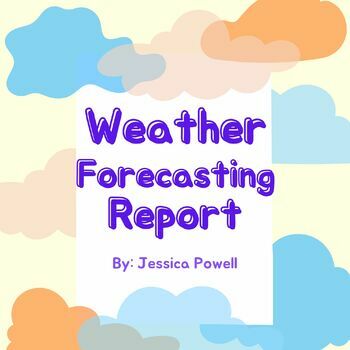Weather Forecasting Report- News Meteorology Project for Weather Unit
Jessica Powell
3 Followers
Grade Levels
6th - 9th
Subjects
Standards
NGSSMS-ESS2-4
NGSSMS-ESS2-6
NGSSMS-ESS2-5
Formats Included
- Zip
Pages
41 pages
Jessica Powell
3 Followers
Description
This is a great project for the end of your weather unit. Students can show their understandings of different weather phenomenon like fronts, radar, temperature, pressure systems and how they all work together.
Included:
- An easy fill in the blank outline for a report that the students will use when interpreting a weather map just like a meteorologist
- Tips for teachers using this
- Outline for how to use it in class
- Rubric for easy grading and an outline for the students to know they are on track
- Sign up sheet if you want to have the students spread out when they film their report
- Instructions to get the daily weather maps from wunderground.com
- 30 different weather maps for students to use for their project.
This is a great alternative to a test for students to show what they and they understand how the different weather phenomenon affect the weather we see at ground level.
Other products you may like:
Total Pages
41 pages
Answer Key
Included with rubric
Teaching Duration
90 minutes
Last updated May 26th, 2023
Report this resource to TPT
Reported resources will be reviewed by our team. Report this resource to let us know if this resource violates TPT’s content guidelines.
Standards
to see state-specific standards (only available in the US).
NGSSMS-ESS2-4
Develop a model to describe the cycling of water through Earth’s systems driven by energy from the sun and the force of gravity. Emphasis is on the ways water changes its state as it moves through the multiple pathways of the hydrologic cycle. Examples of models can be conceptual or physical. A quantitative understanding of the latent heats of vaporization and fusion is not assessed.
NGSSMS-ESS2-6
Develop and use a model to describe how unequal heating and rotation of the Earth cause patterns of atmospheric and oceanic circulation that determine regional climates. Emphasis is on how patterns vary by latitude, altitude, and geographic land distribution. Emphasis of atmospheric circulation is on the sunlight-driven latitudinal banding, the Coriolis effect, and resulting prevailing winds; emphasis of ocean circulation is on the transfer of heat by the global ocean convection cycle, which is constrained by the Coriolis effect and the outlines of continents. Examples of models can be diagrams, maps and globes, or digital representations. Assessment does not include the dynamics of the Coriolis effect.
NGSSMS-ESS2-5
Collect data to provide evidence for how the motions and complex interactions of air masses result in changes in weather conditions. Emphasis is on how air masses flow from regions of high pressure to low pressure, causing weather (defined by temperature, pressure, humidity, precipitation, and wind) at a fixed location to change over time, and how sudden changes in weather can result when different air masses collide. Emphasis is on how weather can be predicted within probabilistic ranges. Examples of data can be provided to students (such as weather maps, diagrams, and visualizations) or obtained through laboratory experiments (such as with condensation). Assessment does not include recalling the names of cloud types or weather symbols used on weather maps or the reported diagrams from weather stations.




